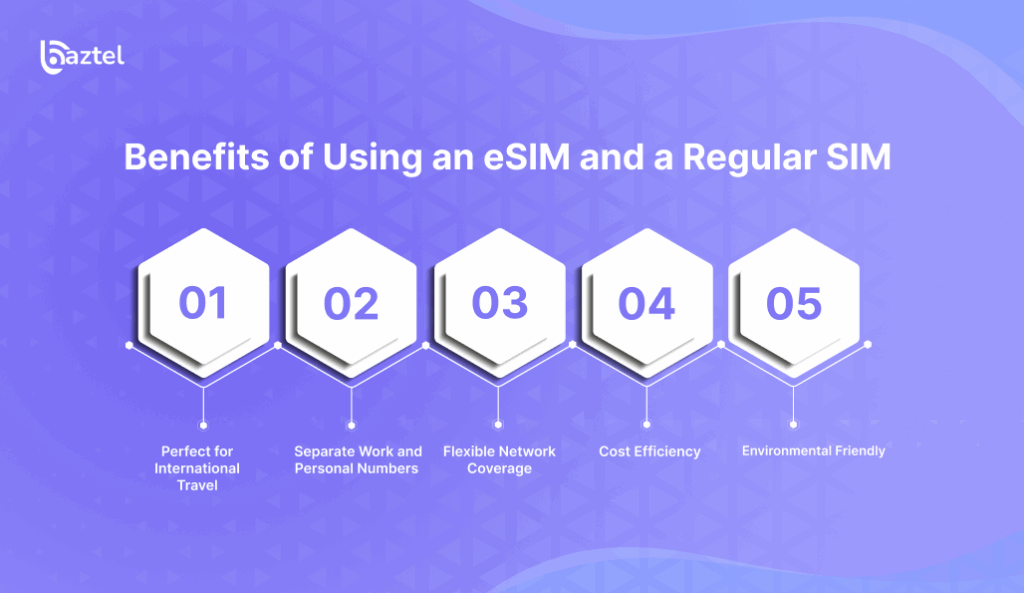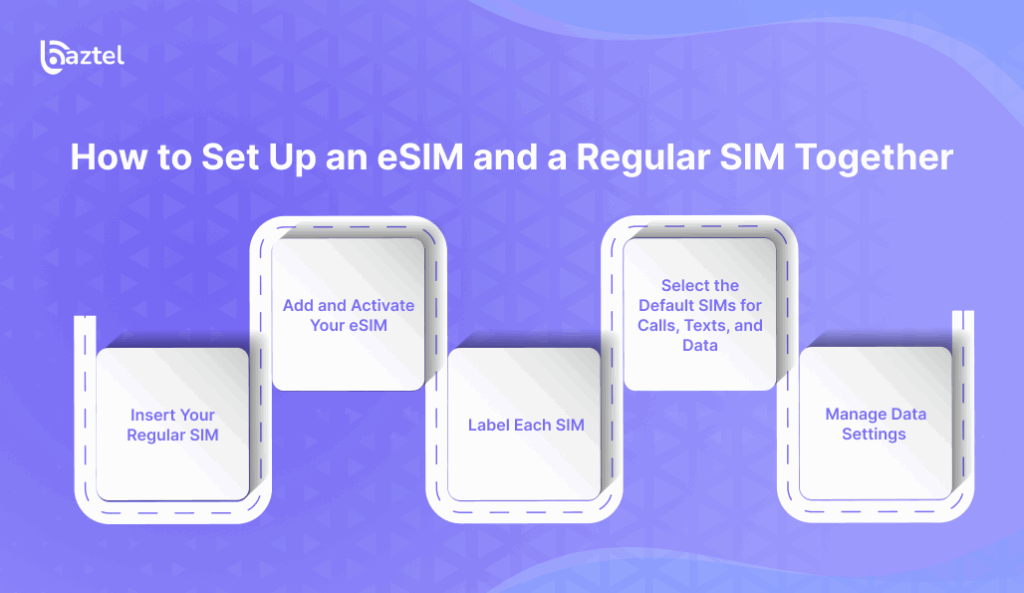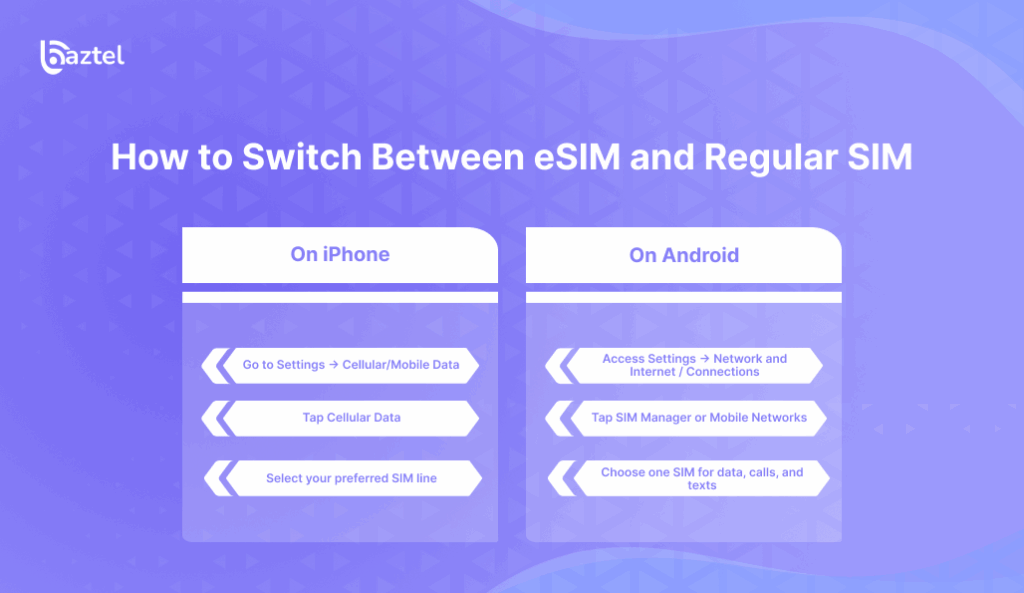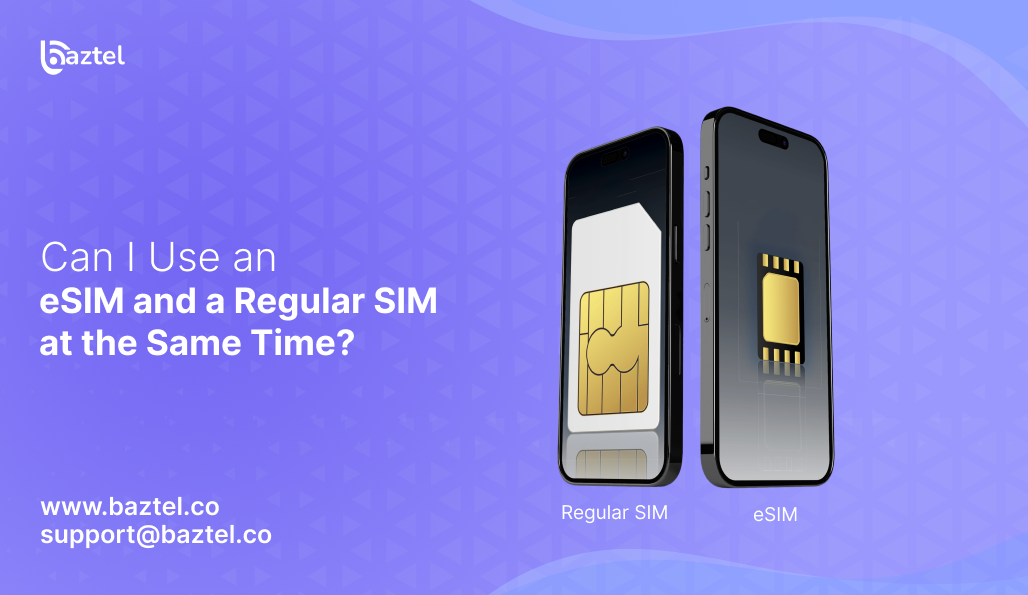In the fast-paced, ever-changing world of mobile tech, smartphone users often ask one question: can you really use both an eSIM and a regular SIM card at the same time?
The answer is very simple
Yes, you can use both of them without any issue.
The latest smartphones that are coming out these days usually have dual SIM support as a standard feature, including the case of a regular SIM and an eSIM combination. To use both an eSIM and a regular SIM at the same time, you need a compatible device with dual SIM capability, such as recent iPhone models or many Android devices. Therefore, users can easily and very cleverly use two mobile numbers or data plans on one mobile device, which is of great benefit to people who travel frequently for business or leisure or simply do not want to go through the hassle of handling two mobile phones at the same time.
The combination of the two SIMs is not only a great option but also a very flexible and cost-saving solution for the users. Depending on which line has been allocated for each task, you can make and receive calls, send texts, and even use mobile data simultaneously. For instance, a user can assign the regular SIM for voice and SMS, and then keep the eSIM active for internet or overseas travel.
In this blog let’s know the dual system setup in detail: what advantages come with it and how to get the most from both.
What Is an eSIM?
An eSIM, which refers to an embedded SIM, is essentially the virtual version of a regular SIM card. eSIM stands for embedded SIM, and understanding eSIM involves recognizing it as a reprogrammable chip embedded in your device. Rather than the traditional SIM that you place into your device, a tiny SIM card known as an eSIM is built right into the mobile hardware. The eSIM does the same thing that the SIM does, connecting your phone to the carrier’s network digitally, without needing a physical card.
With the use of an eSIM, it becomes possible to get mobile data plans over the air, switch providers instantly, and have several profiles on one device. This means that there will no longer be regular SIM cards, tray swaps, or store visits.
You just need to scan a QR code, click the on-screen prompts, and your eSIM will be good to go in just a few minutes.
What Is a Regular SIM Card?
A regular SIM card (Subscriber Identity Module), the small plastic chip containing your mobile number and carrier info, is used by you to insert it into your smartphone’s SIM tray to get connected to your carrier’s network. Physical SIM cards are traditional removable chips that provide mobile network access.
Regular SIM cards have been in existence for many years and have not lost their popularity. Nevertheless, users can lose, break, or change them, as regular SIM cards are removable. Using physical SIM cards often requires physically swapping SIM cards when changing carriers or numbers. Unlike regular SIMs, eSIMs do not have these issues.
Understanding the Difference Between SIM and eSIM
Regardless of their types, both SIM cards perform the primary function of giving your mobile phone the ability to access a cellular network. Nonetheless, the differences in convenience, installation, and the ability to use both types of SIMs, i.e. eSIM and SIM, have been the criteria for their comparative advantages.
Here’s a quick comparison between the two:
| Feature | Regular SIM | eSIM (Embedded SIM) |
|---|---|---|
| Form Factor | Removable physical card | Digital chip embedded in device |
| Activation | Insert manually | Activated via QR code or app |
| Switching Networks | Requires a new SIM card | Can be done digitally in seconds |
| Storage Capacity | One carrier per card | Multiple plans can be stored |
| Durability | Can be lost or damaged | Cannot be physically damaged |
| Eco-Friendliness | Uses plastic and packaging | Paperless, sustainable, and waste-free |
| Convenience | Manual handling required | Simple, fast, and fully digital |
With modern smartphones, you can use both an eSIM and a physical SIM at the same time, allowing for dual SIM functionality. Most devices support one physical SIM and one eSIM, making it easy to manage multiple numbers or switch between them, especially when traveling. Additionally, you can store multiple eSIM profiles on your device, but only one eSIM profile can be active at a time. This flexibility makes it convenient to switch between different carriers or regional plans as needed.
What Is Dual SIM Technology?
Dual SIM technology allows a smartphone to hold two active connections simultaneously. This can be achieved through:
- Two regular SIMs (traditional dual SIM setup)
- One regular SIM + one eSIM (most common modern setup)
- Two eSIMs (supported by select high-end models)
Dual SIM capability enables users to manage two active phone numbers or data plans on a single device, often using a combination of a physical SIM and an eSIM. Most iPhone models (XR, XS, and newer) and many flagship Android devices support dual SIM with eSIM, and most modern smartphones, like iPhone 13+, support Dual SIM Dual Standby (DSDS) functionality. In fact, most flagship devices manufactured since 2018 support eSIM technology, and iPhone models XS and newer support using a physical SIM and eSIM simultaneously.
When a device comes with double SIM capability, it means that the user is managing two phone numbers, two networks, and even two different data plans all in one device. Besides, it is possible to define which SIM you want for calling, texting, and Internet access thus granting you total flexibility.
For example:
- Make your regular SIM for voice and SMS.
- Take advantage of the cheap data on your second eSIM, particularly when going overseas.
The capability of running two packages at once without having to change the cards is what makes dual SIM mobiles really useful.
How to Use an eSIM and Regular SIM at the Same Time
The process of using a standard SIM along with an eSIM is simple if your mobile supports the dual SIM feature. Most dual SIM devices can accommodate both a physical SIM and an eSIM at the same time, allowing for flexible connectivity options. This is how it operates:
- Primary SIM (standard): This is your primary SIM card, generally linked to your home line for voice, text messages, and sometimes data services.
- Secondary SIM (eSIM): This is a digital SIM that can be switched on for extra data use or a short-term travel plan.
When both are active:
- You can receive calls and texts on both numbers.
- You can assign one for calls and another for data.
- You can switch data usage between the two from your phone’s settings or device settings.
You can easily switch between SIMs for calls, texts, and cellular or mobile data in your device settings or phone’s settings. Only one cellular data network can be active at a time, but you can automatically switch between them as needed for optimal connectivity. You can also choose which SIM to use for iMessage and FaceTime on your device.
Benefits of Using an eSIM and a Regular SIM

Combining an eSIM and regular SIM gives you the best of both worlds. Dual SIM functionality enhances your mobile experience by allowing you to stay connected across different countries, making it easier to manage calls, texts, and data while traveling internationally.
Let’s explore the main benefits!
1. Perfect for International Travel
If you’re traveling abroad, you can keep your home SIM active for calls and texts while using an eSIM for local data, helping you avoid expensive roaming charges. Such a capability would lead to an enhanced mobile experience with flexible connectivity options, especially useful for travelers who are frequently traveling between different countries.
For example, if you live in Australia and wanting to travel to Canada, you can actively keep your home number and actively activate a local eSIM data plan from a supplier like BazTel for Internet access. No need to replace or remove your SIM card; Just scan QR code and connect.
Note: Using dual SIM functionality may cause slightly faster battery drain since your device monitors two networks. Monitor data usage on both SIMs to avoid unexpected charges.
2. Separate Work and Personal Numbers
A dual SIM mobile phone allows a user to utilize two distinct numbers on one gadget. You can assign a custom label to each SIM, such as ‘Work’ and ‘Personal’, to help identify each line on your device. The classic SIM can be used for personal purposes and the digital eSIM for professional talk, thereby having personal and work lines in parallel without need of having two separate phones and accessing both networks simultaneously.
You can amend your labels for each SIM in your device settings for easier management as well as being able to use call forwarding to ensure you don’t miss calls on either number, even when one SIM is in use.
Note: If you are on a call with one SIM, calls to the other number may go to voicemail.
3. Flexible Network Coverage
You can obtain better reception or rates by switching between networks with two active SIMs. Monitoring signal strength for each SIM can help you choose the best network for calls and data. In case your primary SIM network fails, your eSIM can provide a backup connection.
4. Cost Efficiency
The eSIM, in that case, will come to your rescue by letting you compare and select the local data plan at a lower price instead of paying for international roaming. You can also choose and activate an eSIM plan for your destination to maximize savings. This sort of flexibility can lead to huge savings, specifically for the corporate sector. No hidden or additional fees to incur!
5. Environmentally Friendly
The use of eSIMs leads to a decrease in plastic waste and packaging. They are eco-friendly, as they eliminate the need for the usual manufacturing, transportation, and disposal processes. This is small but effective in making the planet a little bit greener.
How to Set Up an eSIM and a Regular SIM Together

Both SIMs can be set up quite easily and right from your phone settings. A detailed guide for iPhone and Android users is provided below:
When adding and activating your travel eSIM, you may be prompted to enter an activation code provided by your carrier. This code is often required after scanning the QR code or during app-based activation to link the eSIM to your device and plan.
Note: Activating a travel eSIM requires a stable internet connection for the initial setup.
Step 1: Insert Your Regular SIM
- Insert the SIM card of your choice into the phone’s SIM slot.
- Make sure that it is activated and already linked to your main network.
Step 2: Add and Activate Your eSIM
- Settings → Mobile Data / Cellular → Add eSIM is the route to follow.
- The QR code that was issued by your carrier can be scanned (or the details entered manually).
- Just a few seconds and your eSIM will be activated silently.
Step 3: Label Each SIM
- Assign any names like “Primary” and “Travel” or “Work” and “Personal.”
- This will help you to better identify, control and maintain multiple profiles in your settings.
Step 4: Select the Default SIMs for Calls, Texts, and Data
- Set the default SIM for voice and SMS as per your choice.
- If you are on a travel plan, then select your eSIM for data consumption.
Step 5: Manage Data Settings
- Real-time switching of the SIM that is using mobile data can be done.
- If you’re going to be traveling abroad, turn on data roaming.
Example Scenario: Managing Both SIMs While Traveling
Let’s take a simple example. Suppose you live in Australia and are traveling to Germany.
- You keep your Australian regular SIM for calls and OTPs.
- You activate a Germany eSIM from Baztel or another provider for local data.
This way, you:
- Stay reachable on your home number.
- Access affordable local data for maps, emails, and social apps.
- Avoid expensive international roaming fees.
When you return home, simply disable your eSIM instead of deleting it. You can reactivate it again during your next trip without reinstalling.
How to Switch Between eSIM and Regular SIM

You can switch your active data line in just a few taps:
On iPhone:
- Go to Settings → Cellular/Mobile Data
- Tap Cellular Data
- Select your preferred SIM line
On Android:
- Access Settings → Network and Internet / Connections
- Tap SIM Manager or Mobile Networks
- Choose one SIM for data, calls, and texts.
This way, you can easily toggle between active lines without the need to pull out and replace SIM cards.
Potential Limitations to Keep in Mind
Dual SIM support is quite useful, but it also comes with some disadvantages, for example:
- Data Line: Only one of the two SIM cards can share the mobile data connection at a time.
- Battery drain: Running two active lines on a mobile phone will increase power consumption slightly.
- Bear compatibility: Some smartphones can prevent the use of eSIM in certain regions or with specific carriers. For example, models like the iPhone XR and iPhone SE (including iPhone SE 2020) support eSIM, but may have regional limitations.
- Network priority: When both SIM cards are live, one of them can be marked as preferred to receive calls.
- Unit support: Phones produced before 2018 may not be eSIM-compatible.
You can check your device’s eSIM compatibility by dialing *#06#—if an EID number displays, your device supports eSIM.
Be sure to check the unlock status and carrying compatibility of your device before activating ESIM.
Why More Users Are Shifting to eSIMs
The growing popularity of eSIMs is not just a trend; it’s the future of mobile connectivity. The benefits of faster activation, remote setup, and sustainable usage have made eSIMs the preferred choice among modern users.
Purchasing a multi-SIM setup is the new trend among world travelers, where one regular SIM card will have the home number, and an eSIM is for local or international data use only.
The eSIM activation process by providers such as BazTel, Airalo, and others has become so smooth that the users can handle their data plans completely online.
Tips for Using eSIM and Regular SIM Together Efficiently
To make the most of your dual SIM setup, keep these tips in mind:
- Label each SIM clearly (e.g., “Work” and “Travel”).
- Switch off unused SIMs when not required to save battery.
- Check data roaming settings before international trips.
- Download eSIMs before you travel to avoid setup issues abroad.
- Use Wi-Fi calling when one SIM has weak network coverage.
The Future of Dual SIM and eSIM Technology
The transition from regular SIM to eSIM is a significant leap in mobile technology. The use of traditional SIM tracks can eventually disappear as more smartphones include the Double eSIM feature. Companies such as Apple, Samsung and Google have already begun to switch to eSIM devices, which will definitely make connections easier for users worldwide.
This change is in line with the worldwide trend of getting smarter, reducing the environmental impact, and providing greater flexibility in mobile solutions.
Conclusion
Can eSIM and ordinary SIM be utilized simultaneously?
Definitely.
Current generation mobiles grant the user the luxury of having two numbers, networks, and plans all in one device. If you are controlling work and personal lines, going abroad, or wanting alternative connectivity, then the dual SIM feature is the best option for mobile management.
Moreover, global operators like BazTel are increasingly offering eSIM-compatible plans, and thus, staying in touch no matter where you are, has become the simplest thing ever.
FAQs
1. Can I use an eSIM along with a regular SIM on any phone?
You may do so only in case your phone is equipped with the dual SIM feature of eSIM possibility. This is a feature that most of the devices launched after 2018 (like iPhone XS or later and high-end Android models) have.
2. Is it possible for both SIM cards to be switched on at same time?
Yes, it is; both SIMs can be on for calls and texting purposes, but only one SIM is allowed to use mobile data at a time. You can easily change the active SIM in your phone’s settings.
3. Is there any limitation in number of eSIMs one can have on single phone?
Not as such; a lot of new devices now let you use more than one eSIM profile (however only one or maybe two can be active at a time). This is particularly useful for people who frequently travel and use different plans.
4. What if I want to get rid of my eSIM?
When you get rid of an eSIM, its data plan is cleared off from your device. If you want to use it again, then you will have to either redownload or request the plan again.
5. Do eSIMs have an impact on the quality or speed of the signal?
No, eSIMs are on par with regular SIMs when it comes to signal quality and speed. The performance of the network is based on the carrier you are with and not the SIM type.
Blog Author
Peter
Peter started BazTel.co to make mobile internet easier for travellers. He noticed how tough it was to find good network options while visiting new countries. That’s when he built BazTel — a place where anyone can buy eSIMs online without confusion or long steps. He believes tech should be simple and useful, not complicated. When he’s free, he likes to travel, test BazTel himself, and keep improving it based on real user problems.

 Botswana
Botswana Zambia
Zambia Congo
Congo Colombia
Colombia China mainland
China mainland Chile
Chile Chad
Chad Central African Republic
Central African Republic Canada
Canada Cameroon
Cameroon Cambodia
Cambodia Burkina Faso
Burkina Faso Bulgaria
Bulgaria Brunei Darussalam
Brunei Darussalam Brazil
Brazil Aland Islands
Aland Islands Bosnia and Herzegovina
Bosnia and Herzegovina Bolivia
Bolivia Belgium
Belgium Belarus
Belarus Bangladesh
Bangladesh Bahrain
Bahrain Azerbaijan
Azerbaijan Austria
Austria Australia
Australia Armenia
Armenia Argentina
Argentina Algeria
Algeria



